
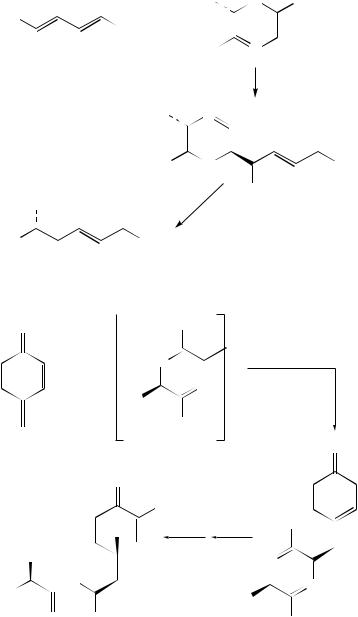
|
8. Nucleophilic additions to dienes, enynes and polyenes |
655 |
||||
|
|
|
Li |
|
|
|
|
|
|
|
|
|
|
|
|
i-Pr |
N |
OMe |
|
|
Ph |
CO2Me |
+ |
|
|
|
|
|
|
|
|
|||
|
|
|
|
|
||
|
|
|
|
|
|
|
|
|
MeO |
N |
|
|
|
|
|
|
i-Pr |
N |
|
|
|
MeO |
N |
|
|
|
HCl |
|
|
NH2 |
|
||
MeO2C |
|
|
CO2Me |
|
|
Ph |
|
||
|
>95% ee/ds |
|
||
|
(58% Yield) |
|
||
O |
|
|
MeO |
|
|
|
|
||
N
+
N
i-Pr
MeO
O
Cl
H
Me
H
+N
H3N
O CO2−
Chlorotetaine
OMe
(18)
CO2Me
Ph
>99% ds (70% Yield)
CuLi
2
O
(19)
MeO
N
N
i-Pr
MeO
(+ 1,4-Adduct)

656 |
Norbert Krause and Claudia Zelder |
4a-methyl-4,4a,5,6-tetrahydro-3H-naphthalen-2-one with Grignard reagents in the presence of Cu(OAc)2 furnished mixtures of 1,2- and 1,6-addition products. The 1,6-adducts consisted mainly of the trans isomer, and the diastereoselectivity increased with increasing steric bulk of the Grignard reagent (equation 20)65. In contrast to this, diastereoselectivities close to 1 : 1 were reported in the Cu(II)-catalyzed 1,6-addition of n-hexylmagnesium bromide65 and the Ni(II)-catalyzed 1,6-addition of alkenylzirconium reagents to the unsubstituted naphthalenone (equation 21)69. The regioselectivity of cuprate additions to bicyclic dienones depends very strongly on the substitution pattern of the Michael acceptor66.
Me
O
1. RMgX |
|
2. Base |
|
|
|
Cu(OAc)2 (cat.) |
|
|
|
|
|
|
Me |
|
Me |
(20) |
|
|
|
|
|
|
|
|
|
|
+ |
|
(+ 1,2-Adduct) |
O |
|
R |
O |
|
R |
RMgX = MeMgI: 93 : 7 EtMgBr: 98 : 2
i-PrMgBr: >99 : <1 t-BuMgCl: >99 : <1
O
Cl |
|
2. Base |
|
|
|
1. Cp2Zr |
R |
|
|
|
|
Ni(acac)2 (cat.) |
|
|
|
|
|
|
|
|
|
(21) |
|
H |
|
|
|||
|
|
|
|||
|
|
|
H |
||
|
|
|
|
+ |
|
O |
|
|
R |
O |
R |
|
|
R = n-Bu: |
59 : 41 |
|
|
|
|
t-Bu: |
46 |
: 54 |
|
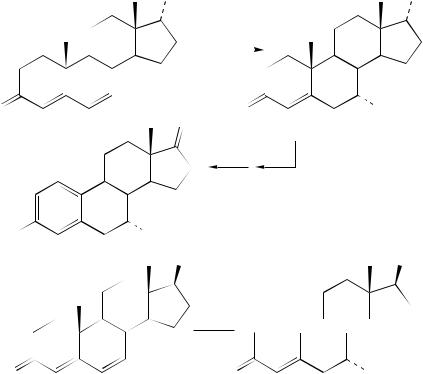
8. Nucleophilic additions to dienes, enynes and polyenes |
657 |
Early investigations of nucleophilic additions of organometallic reagents to 4,6-ste- roids were actually carried out before the discovery of the antiestrogenic behavior of the 7˛ -substituted steroids71 –78. The interest in these transformations was prompted by the desire to prepare new, unnatural corticosteroids with possible interesting pharmacological activities. Campbell and Babcock71 found in 1959 that the diastereoselectivity of the copper-promoted 1,6-addition of MeMgBr to 4,6-steroids depends strongly on the substitution pattern of the substrate: whereas 17ˇ-hydroxy-17˛-methyl-4,6-androstadien- 3-one provided mainly the 7˛-adduct, a mixture of both epimers was obtained from the substrate with an additional 11ˇ-hydroxy group. The preference for the addition of methylmagnesium halides from the ˛-side was also observed by other groups72 –76; for example, Wieland and Auner75 reported an ˛ -selectivity of 90% in the copper-catalyzed 1,6-addition of MeMgBr to 17ˇ-propionyloxy-4,6-androstadien-3-one. The product was converted over several steps into 7˛-methylestrone (equation 22). Interestingly, crossconjugated 1,4,6-steroids also undergo 1,6-addition under these conditions73 75; here, attack of the nucleophile at C-1 seems to be disfavored because of repulsive steric interactions with the adjacent angular methyl group. Other possibilities to introduce a carbon nucleophile regioand stereoselectively in the 7˛-position of 4,6-steroids
is the hydrocyanation with Et2AlCN (equation 23)77 –80 |
and the Sakurai reaction with |
||||
allyltrimethylsilane/TiCl4 (equation 24)81,82. |
|
|
|||
|
OCOEt |
|
OH |
||
|
|
1. MeMgBr |
|
|
|
|
|
CuCl(cat.) |
|
|
|
|
|
|
|
|
|
|
|
2. Base |
|
|
|
O |
|
O |
Me |
(22) |
|
|
O |
|
|||
|
|
|
|||
90% ds
HO |
Me |
OH |
OH |
Et2AlCN



 (23)
(23)
O |
O |
CN |
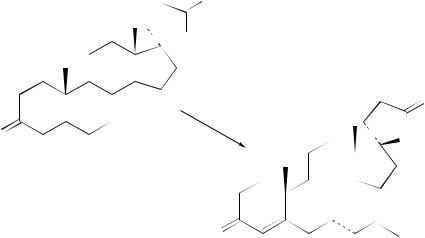
658 |
Norbert Krause and Claudia Zelder |
O

 O
O
O
|
1. H2C |
|
CHCH2SiMe3 |
|
|
||
O |
TiCl4 |
||
2. H+ |
|||
|
|
|
O |
(24)
O
73%
In contrast to these transformations, the introduction of longer alkyl chains by copperpromoted 1,6-addition reactions to 4,6-steroids normally proceeds with unsatisfactory ˛ : ˇ ratios63,83 –88. In some cases, however, the diastereoselectivity could be improved by ‘fine tuning’ of the reaction conditions; for example, the ratio of ˛- and ˇ-epimeric products in the copper-catalyzed 1,6-addition of 4-pentenylmagnesium bromide to 17ˇ- acetoxy-4,6-androstadien-3-one rose from 58 : 42 to 82 : 18 upon variation of the number of equivalents of the nucleophile and the solvent composition (equation 25)88.
B. H-, N-, O-, P-, Seand S-Nucleophiles
Besides carbon nucleophiles, many other nucleophilic reagents can be added regioselectively to acceptor-substituted dienes. The simplest nucleophile is a hydride ion, its synthetic equivalent being a complex metal hydride or another reducing agent. In 1982, Camps ans coworkers89 examined the reaction of sorbic acid with sodium dithionite; in this case, 1,6-reduction took place mainly to furnish 3-hexenoic acid as a mixture of E/Z isomers (equation 26). Likewise, reduction of methyl sorbate and other 2,4-dienoates under these conditions proceeded with high regioselectivities and good chemical yields to furnish the 1,6-reduction products (again as E/Z-mixtures). The reaction probably involves a nucleophilic attack of the sulfoxylate anion, followed by protonation of the
resulting carbanionic species89 –91. |
|
|
|
|
|||
Complex |
hydrides have |
been |
used rather frequently |
for |
the |
conjugate |
reduction |
of activated |
dienes92 –95. |
Just |
and coworkers92 found |
that |
the |
reduction |
of ˛,ˇ- |
unsaturated ketene S,S-acetals with lithium triethylborohydride provided mixtures of 1,4- and 1,6-reduction products which were transformed into enals by treatment with mercuric salts (equation 27). Likewise, tetrahydro-3H-naphthalen-2-ones can be reduced with L-Selectride to the 1,6-reduction products93 –95; this reaction has been utilized in the stereoselective synthesis of several terpenes, e.g. of (R)-( )-ligularenolide (equation 28)95. Other methods for the conjugate reduction of acceptor-substituted dienes involve the use of methylcopper/diisobutylaluminum hydride96 and of the Hantzsch ester
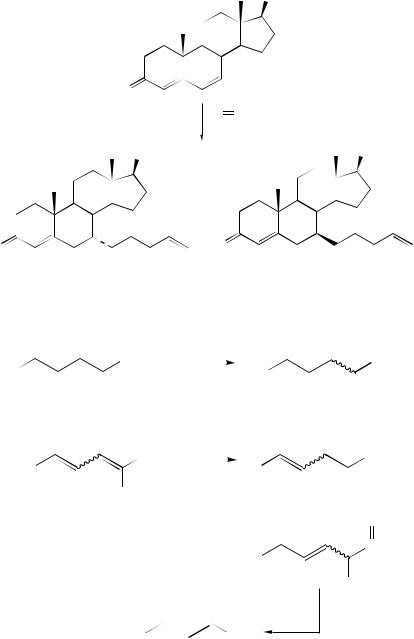
8. Nucleophilic additions to dienes, enynes and polyenes |
659 |
(3,5-diethoxycarbonyl-2,6-dimethyl-1,4-dihydropyridine) in the presence of silica gel97 as nucleophiles.
OAc
O
|
H2C CH(CH2)3MgBr |
|
CuI (cat.) |
OAc |
OAc |
(25)
+
O |
|
|
|
|
O |
|
|
|
|
||
|
Eq. Grignard |
|
|
Ratio THF / diethyl ether |
α : β |
|
|||||
12 |
|
|
|
|
1 : 9 |
|
58 : 42 |
|
|
||
12 |
|
|
|
|
1 : 4 |
|
60 : 40 |
|
|
||
12 |
|
|
|
|
1 : 1 |
|
78 : 22 |
|
|
||
4 |
|
|
|
|
1 : 1 |
|
82 : 18 |
|
|
||
|
CO2R2 |
Na2S2O4 |
|
|
|
|
CO2R2 |
||||
|
NaHCO3 |
|
|||||||||
R1 |
|
|
|
|
R1 |
||||||
|
|
|
|
|
|
NaOH |
(26) |
||||
|
|
|
|
|
|
H2O |
|||||
|
|
|
|
|
|
|
|
|
|
||
R1 = Me, n-C5H11, n-C7H15; |
|
|
R2 = H, Me, Et |
|
|
|
|
||||
|
|
O |
|
|
|
O |
|||||
|
|
|
|
|
LiBEt3H |
|
|
|
|
||
|
|
SEt |
|
SEt |
|||||||
Ph |
|
|
|
|
|
Ph |
|||||
|
SEt |
|
|
|
|
|
|
SEt |
|||
+ O
(27)
SEt
Ph
SEt
Hg2+
Ph |
CHO |
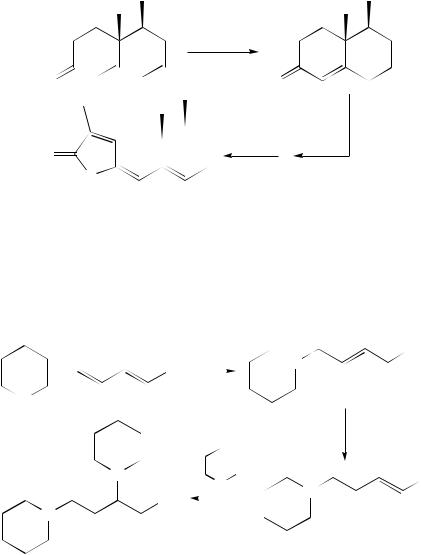
660 |
Norbert Krause and Claudia Zelder |
1.LiB(Bu-s)3H
2.NaOMe
O 
 O
O
(28)
O
O
(R)-(−)-Ligularenolide
Nucleophilic additions of amines to acceptor-substituted dienes were examined as early as 1950. Frankel and coworkers98 found that the reaction of 2,4-pentadienenitrile with various secondary amines proceeded regioselectively to furnish the 1,6-addition products (equation 29). In some cases, these could converted into the 2,4-diamino-substituted pentanenitriles by isomerization and 1,4-addition of a second molecule of amine. Analogous results were reported by other groups17,99,100 and extended to hydrazine as nucleophile101 and to vinylcyclobutenones48 and dienoates102 –104 as Michael acceptors.
CN
+ |
CN |
|
N |
|
|
||
|
|
|
N
H
(29)
N |
CN |
|
|
N |
|
|
N |
|
CN |
H |
|
|
|
|
N
Recently, metalated amines were utilized in stereoselective addition reactions to activated dienes. In a series of papers, Yamamoto and coworkers105 –107 described new stereoselective syntheses of ˇ-lactams utilizing 1,4-addition reactions of lithium amides and amidocuprates to 2,4-dienoic acid derivatives. For example, regioand diastereoselective addition of the amidocuprate [Bn(TMS)N]2CuLi ž LiCN to a diene bearing a bornanesultam auxiliary, followed by trapping of the enolate with acetaldehyde and protection, provided the product with three contiguous stereogenic centers which could then be cyclized to the enantioand diastereomerically pure ˇ-lactam (equation 30)105,107.

8. Nucleophilic additions to dienes, enynes and polyenes |
661 |
Alternatively, a chiral lithium amide was added regioand diastereoselectively to an achiral 2,4-dienoate, and the 1,4-addition product formed could again be converted into the desired, stereochemically pure ˇ-lactam (equation 31)106.
|
|
|
|
|
|
|
|
|
|
|
|
|
|
1. [Bn(TMS)N]2CuLi • LiCN |
|
|||||
|
|
|
|
|
|
|
|
|
|
|
|
|
|
2. MeCHO |
|
|
||||
|
N |
Ph 3. TBSCl |
|
|
||||||||||||||||
|
SO2 |
|
|
|
|
|
|
|
|
|
|
|
|
|
|
|
|
|
|
(30) |
|
|
|
|
|
|
|
|
|
|
|
||||||||||
|
O |
|
|
|
|
|
|
|
|
|||||||||||
TBSO |
|
|
|
|
|
|
|
|
|
|
|
|
|
|
|
|
|
|
OTBS |
|
|
|
|
|
|
|
|
|
|
|
|
|
|
|
|
|
|
|
|
||
H |
H |
|
|
|
|
|
|
|
|
|||||||||||
|
|
|
|
|
|
|
|
|
||||||||||||
|
|
|
|
|
Ph |
|
|
|
|
|
|
|
|
|
||||||
|
|
|
|
|
|
|
|
|
|
|
|
|
|
N |
|
Ph |
||||
|
|
|
|
|
|
|
|
|
|
|
|
|
|
|
||||||
|
NBn |
SO2 |
|
|
|
|
|
|
||||||||||||
|
|
|
|
|
|
|
||||||||||||||
O |
|
|
|
|
|
|
|
|
|
|
|
|
|
|
|
H NBn |
|
|||
|
|
|
|
|
|
|
|
|
|
|
|
|
|
|||||||
|
|
|
|
|
|
|
|
|
|
|
|
|
O |
|
||||||
|
|
|
|
|
|
|
|
|
|
|
|
|
|
|
|
|
|
|
OH |
|
|
|
|
|
|
|
|
1. BnN |
Ph |
|
|
||||||||||
|
|
|
|
|
|
|
|
|
|
|
|
|
|
|
|
Ph |
||||
|
|
|
|
|
Ph 2. H+ Li |
|
|
t-BuO2C |
|
|||||||||||
t-BuO2C |
|
|
|
|
|
|
|
|
|
|
|
|
|
|
|
|||||
|
|
|
|
|
|
3. LDA |
|
|
|
|
||||||||||
|
|
|
|
|
|
|
|
|
|
|
|
|
|
|
||||||
|
|
|
|
|
|
|
4. (MeO)3B |
|
|
|
|
|
|
|
BnN |
Ph |
||||
|
|
|
|
|
|
|
5. MeCHO |
|
|
|
|
|
|
|
||||||
(31)
TBSO
H H
Ph
 NH
NH
O
Diastereoselective 1,4- and 1,6-addition reactions of lithium amides to chiral naphthyloxazolines were used by Shimano and Meyers108 –110 for the synthesis of novel amino acids. For example, treatment of (S)-2-(1-naphthyl)-4-t-butyloxazoline with lithiated 1,4-dioxa-8-azaspiro[4.5]decane and iodomethane provided the diastereomerically pure 1,4-addition product with excellent yield; cleavage of the heterocyclic rings then gave the desired ˇ-amino acid (>99% ee/ds; equation 32)108,109. In contrast to this, most acyclic lithium amides reacted with these oxazolines under 1,6-addition; the products were transformed smoothly to υ-amino acid derivatives (equation 33)110.
The number of reports about addition reactions of oxygen nucleophiles to acceptorsubstituted dienes is rather limited. Coffman111 and Kurtz17 examined the reaction of 2,4- pentadienenitrile with sodium methoxide and isolated the 2 : 1 adduct 3,5-dimethoxypen- tanenitrile formed by successive 1,6- and 1,4-additions (equation 34). Analogous treatment
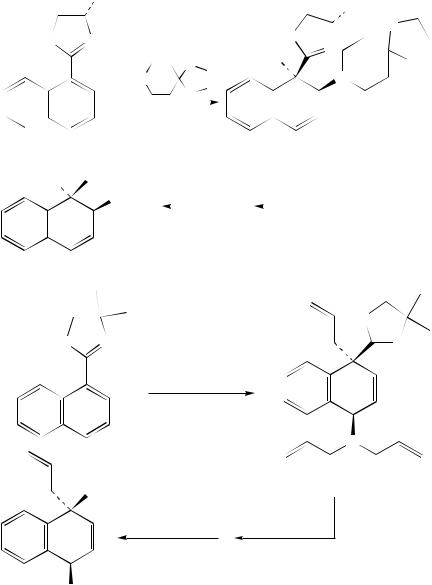
662 |
|
|
Norbert Krause and Claudia Zelder |
|
|
|
|||||||
|
|
Bu-t |
|
|
|
|
|
|
Bu-t |
||||
|
|
|
|
|
|
|
|
|
|
|
|||
|
O |
N |
|
|
|
O |
|
|
O |
||||
|
|
|
|
|
|||||||||
|
|
|
|
|
|
|
|
||||||
|
|
|
|
|
N |
|
|
|
|||||
|
|
|
|
|
|
|
|
|
|
|
|
||
|
|
|
|
O |
|
|
Me |
|
|
O |
|||
|
|
|
|
|
|
|
|
|
|
|
|
||
|
|
|
1. Li–N |
|
|
|
|
|
N |
|
|
|
|
|
|
|
|
O |
|
|
|
|
|
|
|
|
|
|
|
|
|
|
|
|
|
|
|
|
|
||
|
|
|
|
|
|
|
|
|
|
|
|
|
|
|
|
|
2. MeI |
|
|
|
|
|
|
|
|
|
|
|
|
|
|
|
|
|
|
|
|
|
(32) |
||
|
|
|
|
|
|
|
|
>99% ds |
|
|
|
||
Me |
CO2H |
|
|
|
96% Yield |
|
|
|
|||||
|
|
|
|
|
|
|
|
|
|||||
|
|
|
|
|
|
|
|
|
|||||
|
|
|
NH2 |
|
|
|
|
|
|
|
|
|
|
|
|
|
|
|
|
|
|
|
|
|
|
|
|
|
|
|
|
|
|
|
|
|
|
|
|
|
|
>99% ee/ds |
|
|
|
|
|
|
|
|
|
|
|
|
|
|
|
|
|
|
|
|
|
|
|
|
O |
||
|
O |
N |
|
|
|
|
|
|
|
|
N |
||
|
|
|
|
|
|
|
|
|
|||||
1. LiN(CH2CH  CH2)2
CH2)2
2. H2C  CHCH2Br
CHCH2Br
N
>99% ds |
(33) |
|
85% Yield |
||
|
CO2Me
NH2
of 4-chloro-3,5-hexadien-2-one resulted in the incorporation of three methoxy groups by 1,4-addition/elimination, 1,6-addition/isomerization and another 1,4-addition reaction (equation 35)112,113. Recently, Neuenschwander and coworkers114 reported nucleophilic
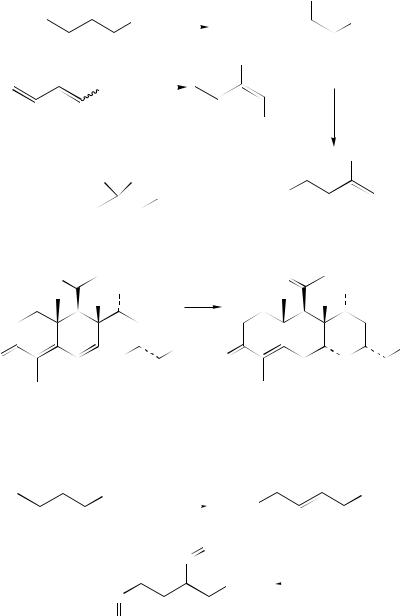
8. Nucleophilic additions to dienes, enynes and polyenes |
663 |
1,6-additions of phenolate and other alcoholates to 2-aminopyrylium salts. An acidcatalyzed intramolecular 1,6-addition served for the stereoselective construction of a key intermediate in a synthetic approach to the natural quassinoid bruceantin (equation 36)115.
|
|
|
|
|
OMe |
|
|
CN NaOMe |
|
|
CN |
(34) |
|||
|
|
|
|||||
|
|
MeOH |
MeO |
|
|||
Cl |
OMe |
|
|||||
COMe |
NaOMe |
|
|
|
|
||
|
|
|
|
|
|
||
MeOH |
|
|
|
|
|||
|
|
|
|
|
|||
|
|
|
|
|
|
NaOMe |
|
|
|
|
|
|
|
MeOH |
|
|
|
|
|
COMe |
|
||
(35)
OMe
MeO OMe
NaOMe
COMe  MeO
MeO
MeOH
MeO
COMe
|
|
|
SiMe3 |
SiMe3 |
||||
O |
|
|
|
|
O |
|
|
|
|
|
|
|
|
|
|
||
|
|
|
|
H+ |
|
|
|
|
CN |
|
|
|
CN |
||||
(36)
|
|
OH |
OH |
O |
HO |
O |
O |
Like oxygen nucleophiles, phosphorus and selenium nucleophiles have been employed rarely in Michael additions to activated dienes. The reaction of phosphites with acceptorsubstituted dienes was studied by several Russian groups116 –118; again, 1,6-adducts and 2 : 1 addition products were formed (equation 37). The acid-catalyzed reaction of selenourea with sorbic acid was also reported to provide a 1,6-addition product119 (equation 38).
CO2Et (EtO)2PONa |
|
|
|
|
CO2Et |
|
|
|
(EtO)2P |
||||
|
|
|||||
|
|
|
|
|
||
|
|
O |
||||
|
(EtO)2P |
O |
(37) |
|||
|
|
|
|
|||
|
|
CO2Et |
(EtO)2PONa |
|
||
|
|
|
|
|||
|
|
|
||||
(EtO)2P
O
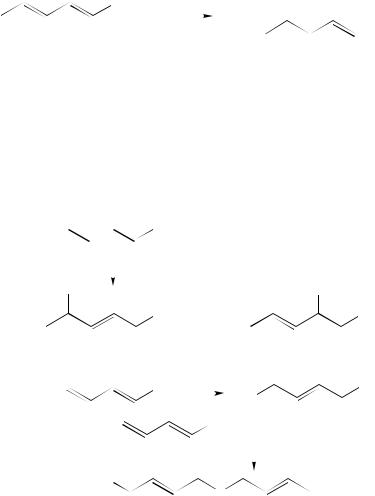
664 |
Norbert Krause and Claudia Zelder |
||||
|
CO2H |
|
(H2N)2C |
|
Se+Cl− |
|
|
|
|||
|
|
|
|||
|
(H2N)2C=Se |
|
(38) |
||
|
|
HCl |
|
CO2H |
|
By far most of the reports on addition reactions of hetero-nucleophiles to activated dienes deal with sulfur-nucleophiles17,48,80,120 –137, in particular in the synthesis of 7ˇ- sulfur-substituted steroids which, like their carbon-substituted counterparts (Section II.A), are of interest because of their ability to inhibit the biosynthesis of estrogens80,129 –137. Early investigations17,120 –122 concentrated on simple acyclic Michael acceptors like methyl sorbate and 2,4-pentadienenitrile. Bravo and coworkers120 observed the formation of a 3 : 1 mixture of the 1,6- and 1,4-adduct in the reaction of methyl sorbate with methanethiol in basic medium (equation 39). In contrast to this, 2,4-pentadienenitrile adds various thiols regioselectively at C-5, i.e. in a 1,6-fashion (equation 40)17,121,122, and the same is true for reactions of this substrate with hydrogen sulfide (equation 41), sodium bisulfite and ethyl thioglycolate17.
CO2Me
KOH |
MeSH |
|
|
|
|
|
|
|
|
|
|
|
|
|
|
|
|
MeS |
+ |
|
MeS |
|
(39) |
|||
|
|
|
|
|
|
|||
|
CO2Me |
|
|
CO2Me |
|
|||
|
|
|
|
|
|
|||
|
|
|
3 : 1 |
|
|
|
|
|
|
|
(92% Yield) |
|
|
|
|||
|
CN |
EtSH |
|
CN |
(40) |
|||
|
|
|
|
EtS |
|
|
||
|
|
|
|
|
|
|
||
2 |
|
CN + H2S |
|
|
|
|||
|
|
|
|
|
Na2S (cat.) |
|
|
(41) |
|
|
|
|
|
|
|
|
|
NC |
|
|
|
|
CN |
|
||
S
The regioselectivity of Michael additions of thiolates to 2,4-dienones can be altered drastically by variation of the reaction conditions and addition of Lewis acids to the reaction mixture. Lawton and coworkers examined the reaction of 2-mercaptoethanol with 1-(3-nitrophenyl)-2,4-pentadien-1-one and observed a high regioselectivity in favor of the 1,6-addition product at 45 °C (equation 42)123,124. Lowering of the reaction temperature caused an increase in the amount of 1,4-adduct, and at 40 °C, a product ratio of 40 : 60 was found. These events suggest that kinetic control favors the 1,4-addition product whereas the 1,6-adduct is thermodynamically more stable. If, however, the reaction was carried out with a complex of the dienone and titanium tetrachloride, only the 1,4-adduct was isolated after hydrolytic workup123. Obviously, this product is trapped as a metal chelate which prevents formation of the 1,6-adduct by retro-Michael/Michael addition. In the absence of the chelating Lewis acid, the 1,4-addition product can indeed be converted
